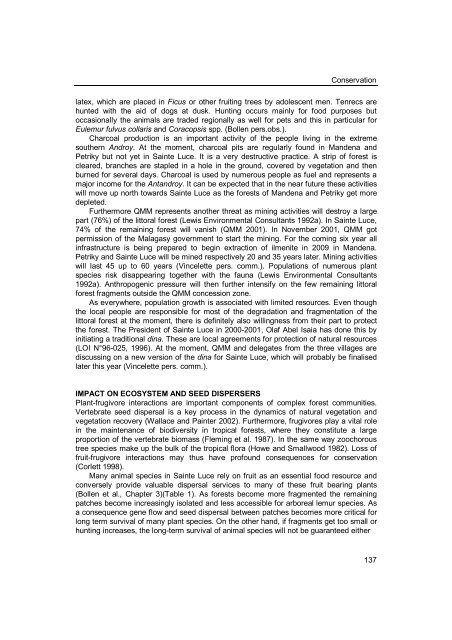Fruit-frugivore interactions in a Malagasy littoral forest - Universiteit ...
Fruit-frugivore interactions in a Malagasy littoral forest - Universiteit ...
Fruit-frugivore interactions in a Malagasy littoral forest - Universiteit ...
You also want an ePaper? Increase the reach of your titles
YUMPU automatically turns print PDFs into web optimized ePapers that Google loves.
Conservation<br />
latex, which are placed <strong>in</strong> Ficus or other fruit<strong>in</strong>g trees by adolescent men. Tenrecs are<br />
hunted with the aid of dogs at dusk. Hunt<strong>in</strong>g occurs ma<strong>in</strong>ly for food purposes but<br />
occasionally the animals are traded regionally as well for pets and this <strong>in</strong> particular for<br />
Eulemur fulvus collaris and Coracopsis spp. (Bollen pers.obs.).<br />
Charcoal production is an important activity of the people liv<strong>in</strong>g <strong>in</strong> the extreme<br />
southern Androy. At the moment, charcoal pits are regularly found <strong>in</strong> Mandena and<br />
Petriky but not yet <strong>in</strong> Sa<strong>in</strong>te Luce. It is a very destructive practice. A strip of <strong>forest</strong> is<br />
cleared, branches are stapled <strong>in</strong> a hole <strong>in</strong> the ground, covered by vegetation and then<br />
burned for several days. Charcoal is used by numerous people as fuel and represents a<br />
major <strong>in</strong>come for the Antandroy. It can be expected that <strong>in</strong> the near future these activities<br />
will move up north towards Sa<strong>in</strong>te Luce as the <strong>forest</strong>s of Mandena and Petriky get more<br />
depleted.<br />
Furthermore QMM represents another threat as m<strong>in</strong><strong>in</strong>g activities will destroy a large<br />
part (76%) of the <strong>littoral</strong> <strong>forest</strong> (Lewis Environmental Consultants 1992a). In Sa<strong>in</strong>te Luce,<br />
74% of the rema<strong>in</strong><strong>in</strong>g <strong>forest</strong> will vanish (QMM 2001). In November 2001, QMM got<br />
permission of the <strong>Malagasy</strong> government to start the m<strong>in</strong><strong>in</strong>g. For the com<strong>in</strong>g six year all<br />
<strong>in</strong>frastructure is be<strong>in</strong>g prepared to beg<strong>in</strong> extraction of ilmenite <strong>in</strong> 2009 <strong>in</strong> Mandena.<br />
Petriky and Sa<strong>in</strong>te Luce will be m<strong>in</strong>ed respectively 20 and 35 years later. M<strong>in</strong><strong>in</strong>g activities<br />
will last 45 up to 60 years (V<strong>in</strong>celette pers. comm.). Populations of numerous plant<br />
species risk disappear<strong>in</strong>g together with the fauna (Lewis Environmental Consultants<br />
1992a). Anthropogenic pressure will then further <strong>in</strong>tensify on the few rema<strong>in</strong><strong>in</strong>g <strong>littoral</strong><br />
<strong>forest</strong> fragments outside the QMM concession zone.<br />
As everywhere, population growth is associated with limited resources. Even though<br />
the local people are responsible for most of the degradation and fragmentation of the<br />
<strong>littoral</strong> <strong>forest</strong> at the moment, there is def<strong>in</strong>itely also will<strong>in</strong>gness from their part to protect<br />
the <strong>forest</strong>. The President of Sa<strong>in</strong>te Luce <strong>in</strong> 2000-2001, Olaf Abel Isaia has done this by<br />
<strong>in</strong>itiat<strong>in</strong>g a traditional d<strong>in</strong>a. These are local agreements for protection of natural resources<br />
(LOI N°96-025, 1996). At the moment, QMM and delegates from the three villages are<br />
discuss<strong>in</strong>g on a new version of the d<strong>in</strong>a for Sa<strong>in</strong>te Luce, which will probably be f<strong>in</strong>alised<br />
later this year (V<strong>in</strong>celette pers. comm.).<br />
IMPACT ON ECOSYSTEM AND SEED DISPERSERS<br />
Plant-<strong>frugivore</strong> <strong><strong>in</strong>teractions</strong> are important components of complex <strong>forest</strong> communities.<br />
Vertebrate seed dispersal is a key process <strong>in</strong> the dynamics of natural vegetation and<br />
vegetation recovery (Wallace and Pa<strong>in</strong>ter 2002). Furthermore, <strong>frugivore</strong>s play a vital role<br />
<strong>in</strong> the ma<strong>in</strong>tenance of biodiversity <strong>in</strong> tropical <strong>forest</strong>s, where they constitute a large<br />
proportion of the vertebrate biomass (Flem<strong>in</strong>g et al. 1987). In the same way zoochorous<br />
tree species make up the bulk of the tropical flora (Howe and Smallwood 1982). Loss of<br />
fruit-<strong>frugivore</strong> <strong><strong>in</strong>teractions</strong> may thus have profound consequences for conservation<br />
(Corlett 1998).<br />
Many animal species <strong>in</strong> Sa<strong>in</strong>te Luce rely on fruit as an essential food resource and<br />
conversely provide valuable dispersal services to many of these fruit bear<strong>in</strong>g plants<br />
(Bollen et al., Chapter 3)(Table 1). As <strong>forest</strong>s become more fragmented the rema<strong>in</strong><strong>in</strong>g<br />
patches become <strong>in</strong>creas<strong>in</strong>gly isolated and less accessible for arboreal lemur species. As<br />
a consequence gene flow and seed dispersal between patches becomes more critical for<br />
long term survival of many plant species. On the other hand, if fragments get too small or<br />
hunt<strong>in</strong>g <strong>in</strong>creases, the long-term survival of animal species will not be guaranteed either<br />
137

















